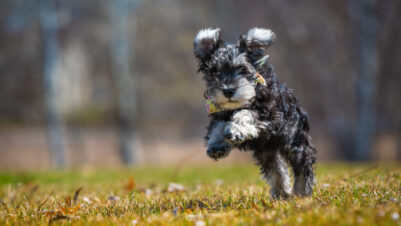New research from the Royal Veterinary College (RVC) has revealed the frequency and risk factors for osteosarcoma across dog breeds in the UK. Osteosarcoma, a cancerous bone tumour, was found to be much more common in giant dogs, including the Scottish Deerhound (3.28 percent of all dogs affected each year), Leonberger (1.48 percent), Great Dane (0.87 percent) and Rottweiler (0.8 percent).
This is the largest study ever undertaken on osteosarcoma in dogs using veterinary clinical records. The results will help owners, veterinarians, breeders and researchers to understand the risks of this important bone cancer in their breed and to update their strategies to support healthier dogs.
Osteosarcoma is a serious malignant bone tumour. Dogs with osteosarcoma often show signs of lameness with bony or soft tissue swelling which can be severely painful. Canine and human osteosarcoma present clinically with similar characteristics, clinical timelines and tumour biology. Therefore, studies on canine osteosarcoma can also be highly valuable in informing studies and knowledge of the disease in humans.
Study findings
This study found that giant dog breeds had a significant risk of osteosarcoma compared to crossbreed dogs. Scottish Deerhounds were 118 times more likely to develop osteosarcoma than crossbreed dogs, Leonbergers were 56 times more likely, Great Danes 34 times and Rottweilers 27 times.
Scottish Deerhounds were 118 times more likely to develop osteosarcoma than crossbreed dogs, Leonbergers were 56 times more likely, Great Danes 34 times and Rottweilers 27 times
Fortunately, the study also identified several breeds with a relatively low risk of osteosarcoma in comparison to crossbreeds, including English Cocker Spaniels (x 0.18 times), Shih Tzus (x 0.12 times) and Jack Russell Terriers (x 0.05 times). The differences between these high-risk and low-risk breeds help us to understand that selecting dogs towards having a giant body size is one of the key drivers for osteosarcoma bone cancer in dogs.
The study was led by the RVC’s VetCompass programme and investigated the frequency of osteosarcoma and associated risk factors in different dog breeds in the UK. The study, using veterinary clinical records, looked at a sample of 905,552 UK dogs, consisting of all breeds under first opinion veterinary care during 2016.
Additional findings include:
- Skull shape influenced osteosarcoma risk. Breeds with long faces (dolichocephalic skulls) had increased risk (x 2.72) of osteosarcoma while breeds with flat faces (brachycephalic skulls) had reduced risk (x 0.50) compared with breeds with medium-length faces (mesocephalic skulls)
- Breeds with a genetic mutation towards shortened legs (chondrodystropy) such as Dachshund and Corgi had reduced risk (x 0.10) of osteosarcoma compared with breeds without this chondrodystrophy mutation (e.g. Labrador Retriever, German Shepherd)
- Insured dogs were 1.71 times more likely to be formally diagnosed with osteosarcoma compared with uninsured dogs, indicating the value of pet insurance to promote improved healthcare for dogs
The study confirms that giant breeds, dogs with heavier bodyweights, longer legs or longer skull lengths are all at higher risk of developing osteosarcoma. As body size (giantism) is controlled by genetic factors, these new results can help owners, veterinarians, breeders and researchers to understand the risk factors for this devastating bone cancer and to update their strategies towards choosing to own or breed healthier dogs with lower osteosarcoma risk in the future. Additionally, these findings will help veterinarians to have higher clinical suspicion of typical signs in dogs showing greater risk factors.
Research implications
Importantly, this new information will also help owners to make more informed choices when deciding on what type of dog to acquire and should encourage us all to prioritise the health of the dog over extreme body shapes. The results can also help researchers to extend the research on osteosarcoma in dogs to improve fundamental and translational bioscience on human osteosarcoma.
Dr Dan O’Neill, Associate Professor in companion animal epidemiology at the RVC, and lead author of the paper, said:
“This new study once again flags the costs that dogs pay for our human drive to own dogs with extreme body shapes that do not occur in nature. By choosing instead to own pet dogs with natural body shapes, we can each do our bit to put the health of the dog above our human whims.”
Dr Grace Edmunds, Clinical Research Fellow, Resident in internal medicine at the University of Bristol and co-author of the paper, said:
“Understanding the biological risk factors associated with any disease can help us to work out what causes it. In this case, the risk factors associated with canine osteosarcoma may tell us what causes a dog’s bone cell to become a cancer cell, and how we can kill that cancer once it develops. For those of us who routinely see osteosarcoma in clinical practice, any step towards new treatments for our canine patients is necessary and exciting.”
Bill Lambert, Health, Welfare and Breeding Services Executive at The Kennel Club, added:
“These data importantly help to identify which dogs are most at risk of osteosarcoma and support the growing body of evidence that this disease is sadly more common amongst larger dogs and particular breeds. The findings will be used collaboratively as part of The Kennel Club’s Breed Health and Conservation Plans, to create strategies to tackle health priorities within those breeds that are affected.”






